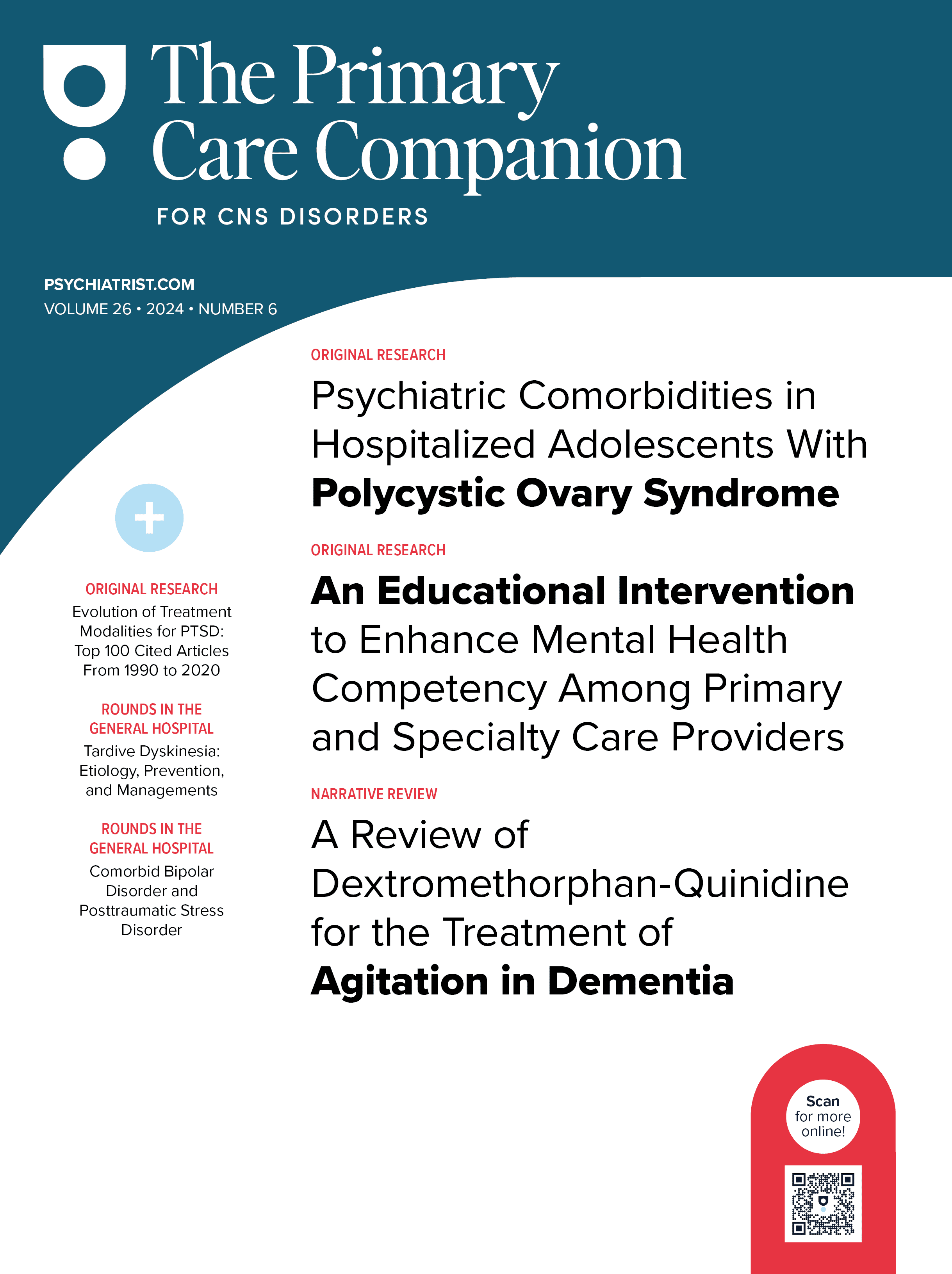Nephrogenic diabetes insipidus is characterized by the inability of distal nephrons of renal tubules to sense and respond to antidiuretic hormone (ADH), leading to increased frequency and amount of urine excretion and excessive thirst. Lithium has been shown to induce desensitization of the renal cells toward the ADH signal, particularly with chronic use.1 Indeed, nephrogenic diabetes insipidus may occur in 10%–15% of patients receiving lithium, and a vast majority of cases are reversible with discontinuation.2 Antipsychotic therapy may potentiate the effect of lithium on the kidney, which we speculate occurred with our patient who developed a nephrogenic diabetes insipidus clinical picture within less than a month, the most accelerated onset we found in the literature to date.3
Case Report
Mr A, a 23-year-old man with a history of schizoaffective disorder (bipolar type) and methamphetamine use, was transferred from an outside hospital where he was evaluated after jumping from a freeway overpass. He was placed on multiple medications for mood stabilization and behavioral agitation throughout the first few weeks of admission, including propofol, ketamine, valproate, paliperidone, quetiapine, guanfacine, lorazepam, and haloperidol. Lithium was added to his regimen on hospital day 15. His serum sodium level was 141 mmol/L, and urine specific gravity was elevated at 1.06. Nine days after starting lithium, his lithium level was 0.7. There was no evidence of prior lithium use for this patient.
After 20 days on lithium, Mr A developed considerable amounts of polydipsia and polyuria, intaking 12 L of fluids per day, prompting an endocrinology consult to assess for central versus nephrogenic diabetes insipidus. Mr A was hypernatremic to 150 mmol/L after fluid restriction with a urine osmolality of 196 mmol/kg. Mr A had a deficit response to desmopressin (urine osmolality to 364 mmol/kg) and elevated copeptin in the setting of hypernatremia, favoring a diagnosis of nephrogenic diabetes insipidus likely due to lithium and possible antipsychotic synergy. Despite head trauma, head computed tomography revealed no intracranial abnormalities that might suggest central diabetes insipidus involvement. Ten days after onset of symptoms, lithium therapy was discontinued. With this intervention, liquid intake decreased, urine specific gravity was 1.006, and serum sodium decreased to 134 mmol/L.
Discussion
Lithium-induced diabetes insipidus is characterized by decreased urinary concentrating ability in the kidneys. Prior studies3 have shown that lithium inhibits expression of aquaporin-2 in the renal collecting duct, likely due to inhibition of adenylate cyclase activity. We hypothesize that the antipsychotics used in our patient modulated the inhibition of adenylate cyclase activity, decreasing sensitivity to ADH and leading to nephrogenic diabetes insipidus.
Nephrogenic diabetes insipidus can have a variety of etiologies, including genetic causes, hypercalcemia, mineralocorticoid excess, and concurrent use of serotonergic antidepressants and lithium.4 However, our patient had none of these characteristics, as his calcium and potassium levels were within normal limits, and he was not on any selective serotonin reuptake inhibitors. Nephrogenic diabetes insipidus secondary to lithium toxicity is typically seen in chronic lithium use, and our patient was only on lithium for 27 days prior to the development of polyuria. There is limited literature suggesting that coadministration with atypical antipsychotics may modulate the deleterious effect of lithium on renal function. In a prior case report, a patient with lithium-induced nephrogenic diabetes insipidus on concurrent antipsychotics (risperidone and quetiapine) had resolution of diabetes insipidus after discontinuing the antipsychotic and onset when risperidone was started again.3
In our patient, the onset of polydipsia with lithium plus antipsychotic use and resolution of symptoms and laboratory findings with lithium discontinuation suggest a significant effect of lithium on the etiology of diabetes insipidus. While antipsychotics have been shown to not be an independent risk factor for diabetes insipidus,4 we hypothesize that the concomitant use of these medications with lithium might accelerate the development of the condition by decreasing expression of aquaporin-2 channels in the renal tubules. We encourage more detailed studies to delineate the underlying mechanism and help guide future clinical management.
Article Information
Published Online: June 22, 2023. https://doi.org/10.4088/PCC.22cr03427
© 2023 Physicians Postgraduate Press, Inc.
Prim Care Companion CNS Disord. 2023;25(3):22cr03427
To Cite: Gopisetty DD, Gunther M, Jiang S. Accelerated-onset diabetes insipidus secondary to lithium use. Prim Care Companion CNS Disord. 2023;25(3):22cr03427.
Author Affiliations: Department of Psychiatry and Behavioral Sciences, Stanford University School of Medicine, Stanford, California (Gopisetty, Gunther, Jiang).
Corresponding Author: Deepti Divya Gopisetty, BA, 330 E Charleston Rd, Palo Alto, CA 94305 ([email protected]).
Relevant Financial Relationships: None.
Funding/support: None.
Patient Consent: Consent was received from the patient to publish the report, and information has been de-identified to protect anonymity.
References (4)

- Behl T, Kotwani A, Kaur I, et al. Mechanisms of prolonged lithium therapy-induced nephrogenic diabetes insipidus. Eur J Pharmacol. 2015;755:27–33. PubMed CrossRef
- Finch CK. Brooks TWA, Yam P, et al.Management and treatment of lithium-induced nephrogenic diabetes insipidus. Therapy. 2005;2(4):669–675. CrossRef
- Erden A, Karagöz H, Başak M, et al. Lithium intoxication and nephrogenic diabetes insipidus: a case report and review of literature. Int J Gen Med. 2013;6:535–539. PubMed CrossRef
- Movig KLL, Baumgarten R, Leufkens HGM, et al. Risk factors for the development of lithium-induced polyuria. Br J Psychiatry. 2003;182(4):319–323. PubMed CrossRef
Please sign in or purchase this PDF for $40.
Save
Cite

